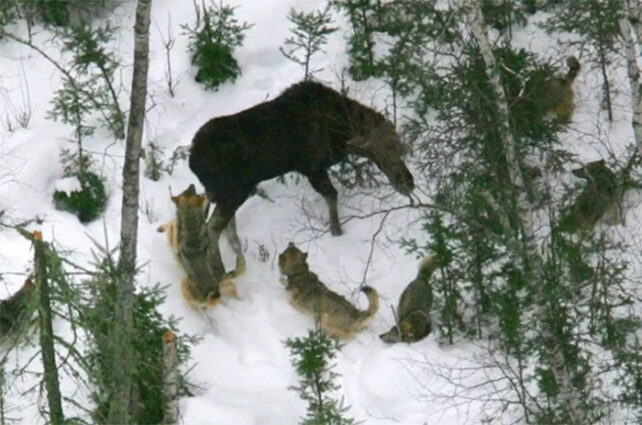In 1997, a lone wolf crossed the ice bridge that briefly connected Canada to the remote island of Isle Royale, located off the Michigan coast of Lake Superior and known for its rich biodiversity. According to a study published Wednesday in the journal Science Advances, its arrival has rekindled the lost wealth of the broader wolf population suffering from diseases and inbreeding, initiating cascading effects that improve the health of the entire forest ecosystem.
“Issues like consanguinity and low genetic diversity are major concerns for scientists,” first author Sarah Hoy, an ecologist at Michigan Technological University, told AFP. “But this is the first study to show that when you have genetic problems, they don’t just affect a particular population and increase the risk of extinction: they also greatly affect all other species.”
“Old Gray Man”
The first wolves arrived on the island in the late 1940s, and their main prey was deer, leading to the world’s longest study of the predator-prey system. But in the 1980s, wolves got into trouble due to the emergence of canine parvovirus, and the number of wolves fell from 50 to about 12. Although the disease eventually disappeared, the population did not recover immediately. This was due to severe inbreeding, which resulted in reduced reproductive success and health problems such as spinal deformities often seen in purebred dogs.
“If you’re a wild wolf and have to hunt like a deer eight times larger than you, that can make life in the wild very difficult for you,” Hoy said.
An immigrant, whom scientists identify as “M93” but affectionately nicknamed “The Old Gray Man,” emerges.
M93 was unrelated to the current population and also had the advantage of being extremely large; A great advantage when defending turf against opponents or taking down 800-pound hoofed animals. He soon became a breeding male in one of the island’s three wolf packs and fathered 34 cubs, greatly increasing the population’s genetic health and prey kill rate.

Restoration of balance
Elks are voracious herbivores and consume up to 14 kilograms of vegetation a day. Wolves helped restore balance in the forest by reducing their numbers; this is most noticeable in the effect on balsam firs, a species often used as a Christmas tree.
With elk dwindling, trees began to grow at rates not seen in decades; this is vital for the regeneration of the forest and the many plant and animal species that depend on it.
The benefits of the M93 launch lasted for nearly a decade, then the situation deteriorated again, ironically as a result of its extraordinary reproductive success.
In 2008, two years after his death, 60 percent of the wolf population’s gene pool was inherited from M93, causing the genetic disruption to return.
M93 began mating with her daughter after her partner died, and simultaneous inbreeding of other members caused the population to decline rapidly by 2015; Only two wolves remain here: a father-daughter couple who are also half-brothers.
Fortunately, a rescue program launched in 2018 has rebalanced the system, and there are now about 30 wolves and just under a thousand deer on the island. According to Hoy, the main conclusion to be drawn is that the principle of adding only a small number of individuals can be applied to other carnivorous populations that suffer from the detrimental effects of inbreeding, such as lions or cheetahs, to similarly improve their ecosystems.
William Ripple, a professor of ecology at Oregon State University who was not involved in the research, told AFP that this is a “significant study” that advances understanding “by showing that genetic processes can limit the ecological consequences of one of the keystone species, the gray wolf.” ” Source
Source: Port Altele
